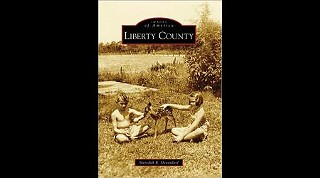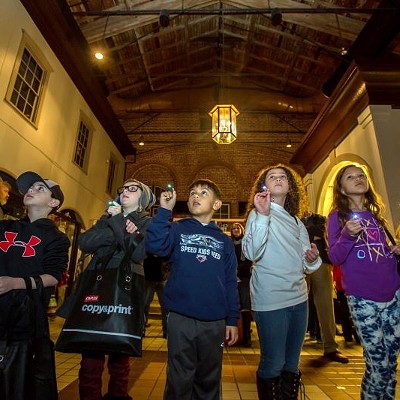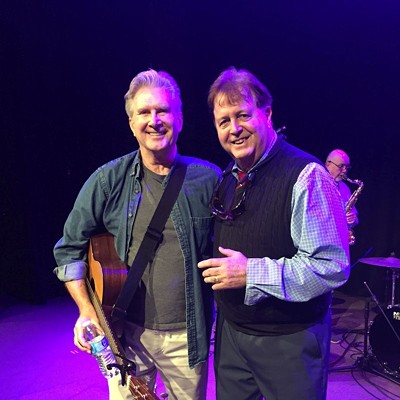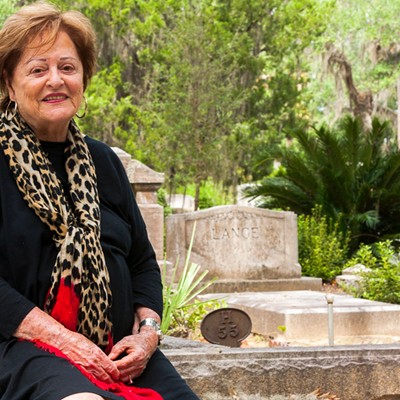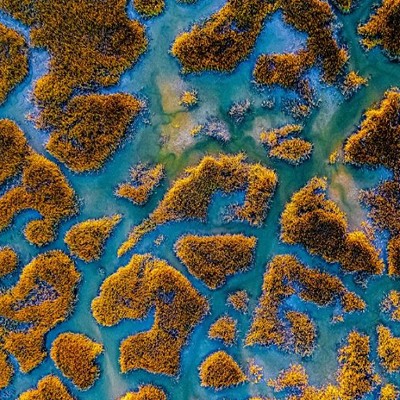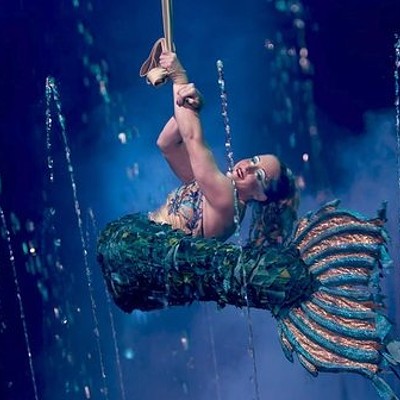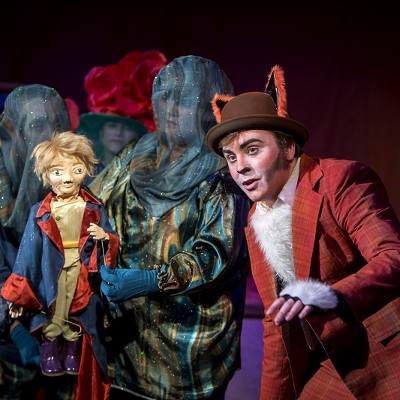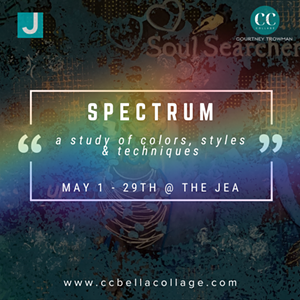In case you're worrying about what you're going to give that literary lion in your life for Christmas, worry no more. Here are our reviews of some recent local releases, most of which you can find in local bookstores.
Keep in mind that while there are tons of locally-themed books out there, here we're reviewing the books which the authors were thoughtful enough to send us review copies of.
Johnny Mercer: The Life, Times and Song Lyrics of Our Huckleberry Friend
Collected and edited by Bob Bach and Ginger Mercer; Cherokee Publishing
The Savannah Cook Book
by Harriet Ross Colquitt (introduction by Ogden Nash); Cherokee Publishing
Savannah native Ken Boyd is doing some amazing work at his Marietta-based publishing house, digging up important old books with enormous local and regional interest and reissuing them in historically authentic form. He doesn't disappoint with these two gems from back in the day, either of which would make great Savannah-themed gifts.
The upgraded reissue of Johnny Mercer: The Life, Times and Song Lyrics of Our Huckleberry Friend, co-written by Mercer's late wife Ginger, comes just in time for the centennial of the great lyricist's birth. Rare photos (some never previously seen), memorabilia, interviews, and of course all those incredible song lyrics are all here in one keepsake volume.
Viewing all this archival material really brings home the enormous influence Mercer had, and has, on American pop culture. In a time when most music careers last only a few years, what's really impressive - besides his preternatural linguistic talent and ear for rhythm - is Mercer's longevity. While most productive from the '30-'50s - the time period most represented in this book - he remained a force well into the 1960s.
First published in 1933, The Savannah Cook Book remains - along with that other Lowcountry classic, Charleston Receipts from 1950 - one of the must-have historic regional cookbooks. As with almost all of his reissues at Cherokee Publishing, Boyd takes great pains to recreate the book almost exactly as it would have appeared when it was first published.
The book opens with a typically whimsical poem by the great light verse writer Ogden Nash, including the couplet "If you like dishes made out of a piece of lettuce and ground up peanuts and a maraschino cherry and marshmallow whip and a banana/ You will not get them in Savannah."
The book includes the original, delightful - and quite politically incorrect by today's standards - "decorations," or sketches, by Florence Olmstead.
As for the recipes themselves - "receipts" in old Southern lingo - they run the gamut from "Mrs. Habersham's Terrapin Stew" (including a modern disclaimer that "all species of marine sea turtles are protected by state and federal laws") to "Colonial Warrior's Chicken Pie" (described as the "piece de resistance of the basket luncheon at the annual river trip" of the Society of Colonial Wars) to "Tipsy Squire," a sponge cake dessert using almonds and sherry.
Savannah Cemeteries
by Matthew Probst; Schiffer
This photo-heavy mini-coffee table book eschews the stylized approach to photographing cemeteries - i..e, all black and white, or massively Photoshopped - instead using a smorgasbord of techniques, from sepiatone to full color to panoramic. While the effect is somewhat jarring at first, after a few pages you get used to the kinetic visual narrative.
The book is divided by cemetery, with each chapter kicked off with a smart, concise diagrammatic map of the graveyard. Of course Bonaventure takes up the most room, and the Colonial Park Cemetery has a large (perhaps too large) section. There is also a well-done chapter on Laurel Grove Cemetery - in my opinion every bit the equal of Bonaventure in poignant beauty - and a brief look at some other lesser-known graveyards, such as the Old Jewish Cemetery, Catholic Cemetery, and a page of oddities.
The text does offer some real, if somewhat dry, insight into the unique customs of Lowcountry cemeteries. I do wish the publisher would have gone with a more attractive body copy font.
Georgia Women: Their Lives and Times, Volume 1
Edited by Ann Short Chirhart and Betty Wood; University of Georgia Press
For those of you weary of being told Georgia history basically boils down to James Oglethorpe, William T. Sherman and Martin Luther King Jr., here is a book exploring the lives and work of 18 women who made indelible impacts on the Peach State.
While to be sure, this well-researched collection of essays - informative while thankfully eminently readable - covers a couple of fairly well-known names, Juliette Gordon Low chief among them, the bulk comprises the compelling life stories of much lesser-known but nonetheless incredibly influential women.
The definitions of "Georgia women" here are necessarily loose. Perhaps the most crucial chapter actually deals with an Englishwoman, the famed actress Fanny Kemble. Her marriage into the Butler family - largest slaveowners in America at the time - and subsequent visit to her husband's plantation on the Altamaha River in the early 1800s led her to write the first globally influential abolitionist work, Journal of Life on a Georgia Plantation, based on her observations of the suffering she saw.
Another chapter near and dear to the Savannah heart features Mary Musgrove, the Creek Indian with extensive white ties who not only served as a Sacajawea of sorts as Oglethorpe's interpreter but was also one of the most crafty politicians the state has produced.
You'll also learn about early women's suffrage champion Mary Latimer McLendon, Revolutionary War heroine Nancy Hart, and Susie King Taylor, an African American woman whose face graces the cover, who wrote a chronicle of her time serving as nurse to a black Civil War regiment, and for whom one of the Savannah River ferries is named.
Images of America: Liberty County
by Meredith R. Devendorf; Arcadia Publishing
Over the years Arcadia Publishing has sent me dozens of review copies of their photo-dominated regional history books. I can say without hesitation that Devendorf's book on Liberty County, Ga., is by far the best I've seen.
The author is herself the scion of a well-established coastal Georgia family, and the range of photos she has acquired is suitably and impressively wide. They span stark Civil War-era photos of abandoned plantations to hard-to-find U.S. Army photos of Fort Stewart (then called Camp Stewart) to copious, and often quite charming, photos from her family's vast personal collection.
The most stunning photos in the book come from the late 19th century work of Julia King, an early master photographer and local historian whose portraits of African American life on the coast can stand with any photojournalism I've seen, and which could easily be the subject of their own volume.
Other highlights include an evocative photo of the oldest surviving St. Simons Island slave, a very rare shot of a meeting in progress within the historic Midway Church, and a photo of archaeologist David Hurst Thomas working on his historic St. Catherine's Island find of the fabled Spanish mission Santa Catalina de Guale.
The most entertaining section is the spread on the 19th century practice of "marooning," a pasttime in which young people would take the family boat and "strand" themselves on one of the many hammocks and islands dotting the coastline for a romanticized camping adventure.
But Devendorf is no mere collator of photographs. Her sharp, informative, and often entertaining photo captions are a history book all their own, and you are guaranteed to learn a great deal of little-known regional history in addition to enjoying this fascinating compendium of vintage photos.
The Deen Bros. Take It Easy
by Jamie and Bobby Deen (foreword by Paula Deen); Ballantine Books
Subtitled "Quick and Affordable Meals the Whole Family Will Love," this cookbook surely has thoses bases covered, and will just as surely be a big hit with the tourists and other Deen family fans. Fans of the boys will enjoy the shots of them chillin' around the grill, quaffing Corona Light while modeling Georgia Bulldog merchandise.
(Yes, sensitive people, I'm making fun of them. It's OK - they made more money in the last five days than I will make in the next five years, so the joke's on me, isn't it?)
Written with that particular downhome appeal that is part and parcel of the Deen Brand - what used to be called "lowbrow appeal" in a less politically correct age - the text of the book contains such typical platitudes as "We hadn't had Mama's pork chops and rice bake in years when Bobby - who is on a pork chop kick - decided it was worth reviving" and "We try to heat a healthy, balanced diet, but you know Paula Deen's boys have a taste for rich, creamy sauces."
Oy. But of course you didn't buy a Deen cookbook for the prose, you bought it for the recipes. And the recipes contain a few daring must-tries amidst the usual fatty-but-bland Southern food that is the Deen trademark.
In particular, I'll be sure to try the Grilled Bacon and Cheese Jalapeno Poppers, the Grilled Cheesy Olive Bread, and the All-Day Beef Chili. (It's annoying to be informed that a "Frito pie," a.k.a., chili and cheese over Fritos, is a Southern invention, when actually it was a staple in West Texas and New Mexico decades before anyone in the old cottton South ever heard of it. That said, it is a great idea and one that should be spread far and wide.)
The Owens-Thomas House
by Tania June Sammons; Telfair Books
This in-house guide to Savannah's most exquisite historic home - owned and operated, of course, by the Telfair Museum of Art - is a good bit more than typical gift-shop fodder. Written by the Owens-Thomas House's curator, this gorgeous little book is a particularly nice find in that it contains all the visual beauty of a coffee table book but at a much, much lower price.
The photos of the furnishings of the house are impeccably shot, and the accompanying text is concise and well-written. Sammons uses the work of the house's architect, the matchless William Jay, to weave together the story of the planning, construction, and everyday life of this unique structure, which features some of the earliest indoor plumbing in Georgia -- a system so complex yet effiicent that it could teach us a lot today about sustainable building.
A good portion is devoted to the most exciting recent research going at the Owens-Thomas House, the old slave quarters/carriage house to the rear of the main building. Sammons has also thoughtfully included an extended section dealing with the individuals, free and enslaved, who've been associated with the house over the years, from original owner Richard Richardson to Savannah Mayor George Welshman Owens to the Marquis de Lafayette, who famously addressed an adoring crowd from the balcony on the south side of the main house.
What I Know: Uncommon Wisdom and Universal Truths From 10-year-olds and 100-year-olds
by Roger Emerson Fishman; Potter
While technically not written by a local author, this charming compendium - the subhead exactly describes the content of the book - does feature a few local people, as I discovered while flipping through and seeing a wonderful black and white portrait photo of my former next-door neighbors on 50th Street, the nationally-famous 100-year-old identical twins Eloise Rogers and Lois Fisher (Mrs. Fisher has since sadly passed away).
The premise of the book might seem bland, but the content is what sets it apart. Fishman divides it into loose chapters with titles like "Integrity" and "Parenting." After Fishman's opening come the quotes from various kids and senior citizens. The 10-year-olds' advice is, not surprisingly, the most entertaining, like this snippet from Devin M. of Florida: "Try not to spoil your kids like bananas or you will lose all your money for sure."
What might surprise you is that it is often the best as well. For example, Mike D. of Philadelphia says, "Try not to ship your baby off to day care. That's like throwing time out the window because the quality time you have with your kids is golden."
The Savannah twins are featured on several pages. Here's a quote from the late Mrs. Fisher: "The most important values are to be honest with each other. If you hit somebody's car, you better at least leave your name and say, ‘I'm sorry.' Unfortunately ‘I'm sorry' seems to have went out of style a long time ago. That just burns me up!"
Informally Educated
by Kennesaw; self-published at http://www.lulu.com
This self-published chronicle of a young man's life in middle Georgia spent learning the criminal trades from his psychotically violent and abusive stepfather is compelling in its ability to sum up the conflicted feelings abuse victims feel - that strange mixture of fear, guilt, hyperresponsibility, victimization, and yes, a kind of love, or perhaps deep admiration, for the abusive authority figure.
The stepfather in question is Jack Cooper, who was raised in New York City but who, after a five-year jail term for beating two men to death, ends up in the trailer parks of middle Georgia, planting himself in the family of the author and his hapless mother. From age eight to adulthood, the book chronicles the author's attempts both to cope with the endless mixed messages going on in his head and to separate himself from the chaotic, criminal and ultraviolent life he's been forced into.
While the personal aspects of the tale are well-told and ring true and are clearly very important therapeutically for the author, the book misses an opportunity to delve more into the seedy social history of the various crime organizations that have long dominated semirural areas of Georgia. There are pithy references to the notorious "Dixie Mafia," an actual organization, but I was left wanting more.
Spirits of '76: Ghost Stories of the American Revolution
by Daniel W. Barefoot; John F. Blair
Not written by a local author but nonetheless a good ghost book with a solid portion devoted to Georgia ghosts in general and coastal Georgia ghosts in particular.
I typically loathe ghost books for a number of reasons - beginning with the main reason, i.e., ghosts do not actually exist - but this tome boasts a confidently scholarly point of view that I find attractive. Along the way you're sure to learn a little history of our great nation, and that is always a worthy goal.
The main Savannah Revolutionary War ghost story is of course that of James Habersham Jr. in the Olde Pink House, formerly the Habersham family mansion. Old man Habersham was of course one of the wealthiest slaveowners of colonial times, who had a famous falling with his son James Jr. over the thorny little issue of American independence (Dad was agin' it, son was down with it).
Savannah in Plain View
by Kathy Smith; Pelican Publishing
Surely one of the most unusual local photo books, Savannah in Plain View is the work of Oregon-based photographer Kathy Smith, who has shown a lot of work in Seattle galleries. A self-taught "light leak" photographer, in this book she uses only a 1962 Diana toy camera to chronicle downtown Savannah and Bonaventure Cemetery.
In practical terms, what this means is that each black and white shot is blurry due to the camera's cheap plastic lens. This lends a dreamlike quality to the photos, most of which are details rather than landscape shots. It's an acquired taste, but certainly a change of pace from the usual tourist-market photography books.
Moon Handbook on South Carolina
by Jim Morekis; Avalon Travel Publishing
Heck yes, I'm promoting my own book - someone's got to do it!
If you know anyone planning a trip, weekend or extended, to the great Palmetto State next door, consider giving them this comprehensive travel guide which covers the entire state, from the mountains to the coast, from South of the Border near Dillon to the ruins of the Old Sheldon Church near Yemasee.
Anyone who's picked up my first book in this series, Charleston and Savannah, will note that the Charleston and Beaufort sections here are largely intact from that edition. But the new book pays a lot of attention to Columbia - a very short drive from Savannah - as well as the natural offerings in the Upstate.
(And needless to say there's a section on Myrtle Beach, which remains South Carolina's biggest tourist draw by far.)
I know folks in Savannah barely pay any attention at all to our neighbor to the north over the river, but as someone who spent the better part of a year researching and writing this book - you don't know what you're missing.

